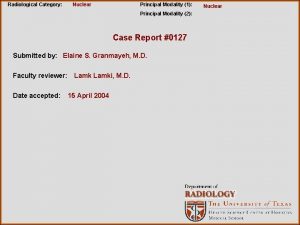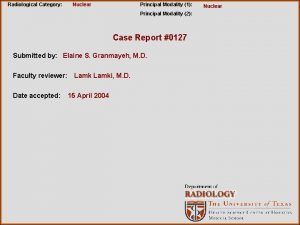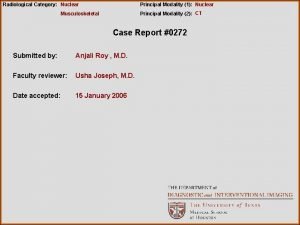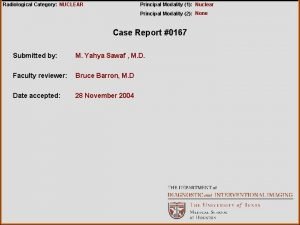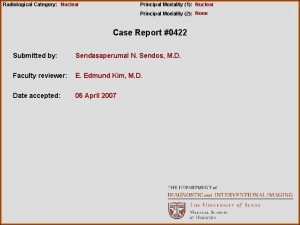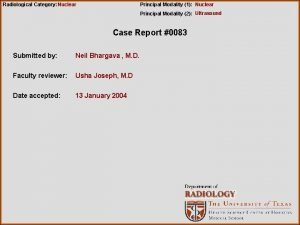Radiological Category Nuclear Principal Modality 1 Nuclear Case







- Slides: 7

Radiological Category: Nuclear Principal Modality (1): Nuclear Case Report #0015 Submitted by: Majdi Radaideh , M. D. Faculty reviewer: Bruce J. Barron, M. D. Date accepted: 29 May 2003

Case History 45 year old female patient with suspected carcinoid tumor. Octreoscan was performed.

Radiological Presentations

Test Your Diagnosis Which one of the following is your choice for the appropriate diagnosis? After your selection, go to next page. 1. 2. 3. 4. Patient motion leading to image degradation. poor tracer preparation. PMT malfunction. COR artifact.

Findings and Differentials Findings: There is a ring artifact in the center of all the SPECT images in all planes indicating an element of improper imaging parameters. In SPECT imaging central blurring or ring artifact is due to COR (Center of rotation) artifact.

Discussion Center of Rotation artifact: The detectors of a SPECT camera rotate around a central axis. The computer makes assumptions about the location of this axis during image reconstruction. The center of rotation corrects for the difference between the center of the computer matirx and the projection of the cameras face. If the COR is calibrated correctly, a point source placed in the center of the cameras orbit during a SPECT acquisition will appear as a point in the center of the computer matrix. If the actual axis does not correspond to the assumed axis, artifacts will be created during image reconstruction (the point will apear blurred or as a ring artifact). Most departments check the center of rotation weekly. Less frequent checks are possible with multi-head detector systems fixed in a rotating gantry. The COR acquisition consists of a point source placed off-center in the field of view. COR should be calculated to a precision of at least one-tenth of a pixel. A shift of 1/2 pixel in the center of rotation can result in significant image degradation. An alignment error in the axis of rotation will result in a point being reconstructed as a ring, thus COR artifacts typically have a "comet tail" or ring-like appearance. Since the artifact is equipment related and constant, it will be present on both stress and rest cardiac images. Reference: J Nucl Med 1993; Juni JE. Doing well under pressure: dedicated SPECT cameras come of age. 34: 1789 -92

Diagnosis COR Artifact in SPECT imaging.








